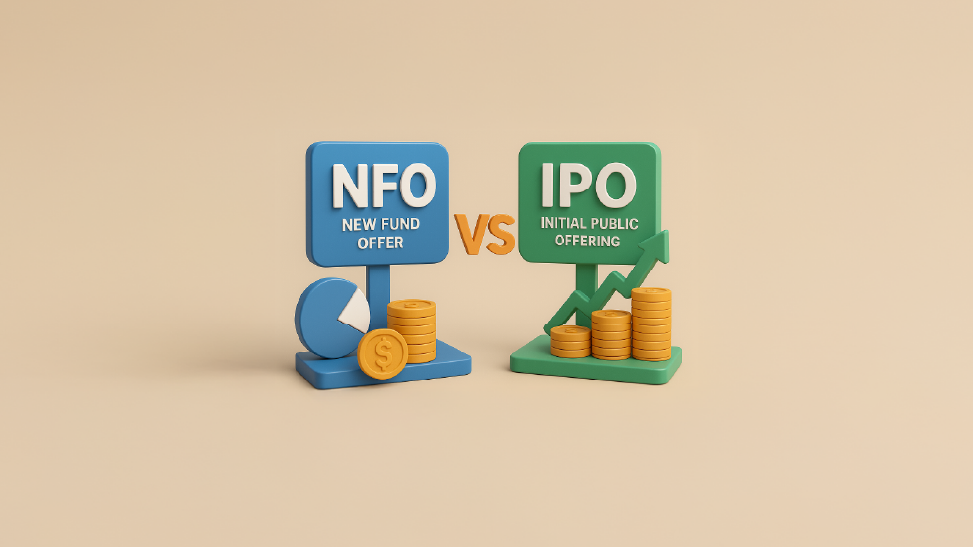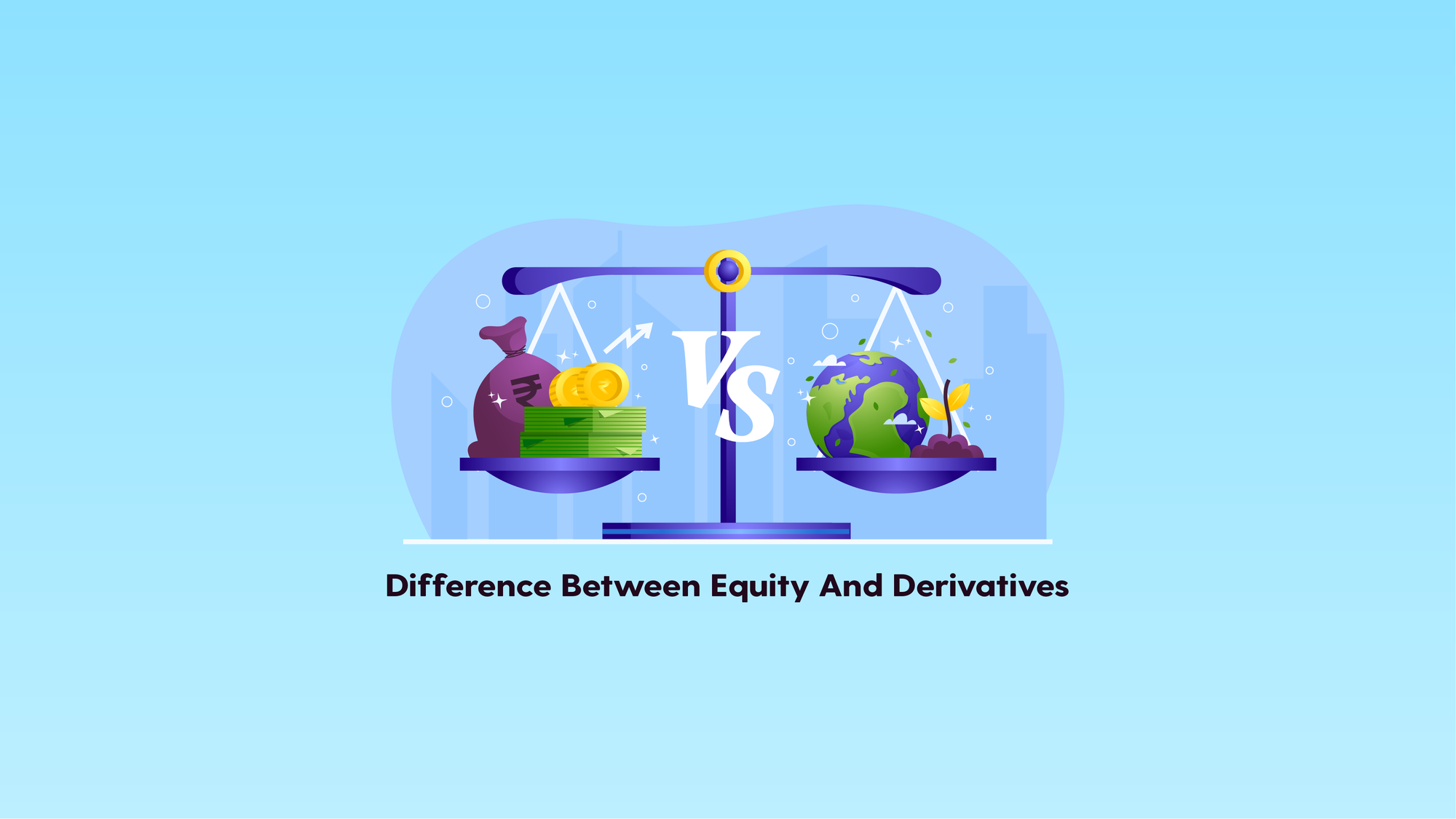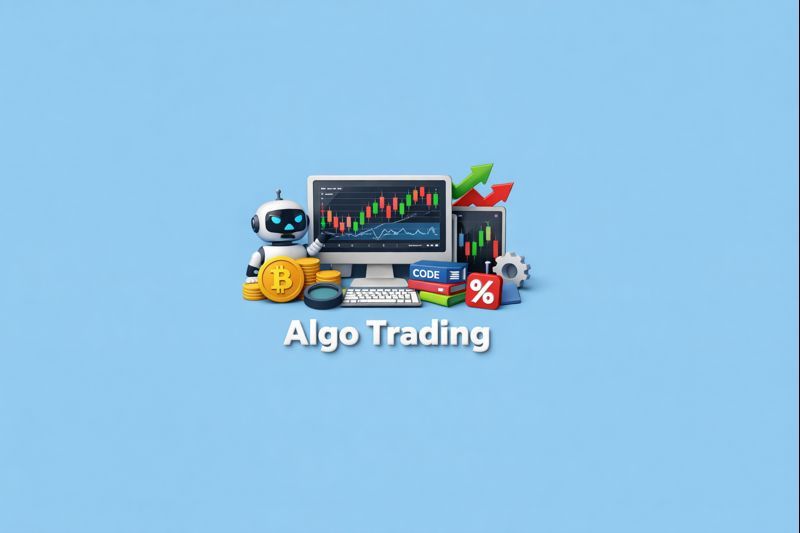NFO vs IPO: Know The Difference Between NFO And IPO

- Published Date: October 16, 2025
- Updated Date: November 24, 2025
- By Team Choice
While exploring IPO opportunities, you may have come across the term NFO. Though the names sound alike, the difference between NFO and IPO is substantial when it comes to purpose, structure, risk, and returns.
In this guide, we break down NFO vs IPO, helping you understand how they work and which option aligns better with your investment goals and risk appetite.
NFO and IPO - A Brief Overview
Before diving into specifics, here’s a brief idea:
- IPO (Initial Public Offering): When a private company offers its shares to the public for the first time.
- NFO (New Fund Offer): When an asset management company launches a new mutual fund scheme to raise capital.
Both are regulated by SEBI, but they function differently and cater to different kinds of investors.
What Is the Difference Between NFO and IPO?
Here’s a table highlighting the key distinctions between IPO and NFO:
| Factor | IPO (Initial Public Offering) | NFO (New Fund Offer) |
|---|---|---|
| Nature of Investment | An IPO allows investors to purchase shares of a company that is going public for the first time. | An NFO is launched by an asset management company (AMC) to introduce a new mutual fund scheme. |
| Purpose | Companies use IPOs to raise capital for expansion, debt repayment, new projects, or to get listed on stock exchanges. | Aims to pool money from investors to invest in a specific strategy, theme, sector, or asset class through a diversified portfolio. |
| Pricing Mechanism | Issued through a fixed price or book-building method, where the price depends on the company's valuation and market demand. | Units are typically offered at a base Net Asset Value (NAV), commonly ₹10, during the offer period. |
| Type of Asset Backing | Shares represent ownership in a specific company with identifiable assets and revenue sources. | Units are backed by a pooled portfolio of securities that the fund will invest in as per its mandate; assets are not predetermined at launch. |
| Ownership vs Instrument | Buying shares in an IPO gives investors ownership (equity stake) in the company. | Investors hold units in a mutual fund but do not own individual companies directly; they own a share of the fund's portfolio. |
| How It Works | Investors apply for shares during the subscription window. Allocation depends on demand. Once listed, shares can be traded on the stock exchange. | Investors subscribe to units during the NFO period. Once closed, the fund deploys the capital, and units are allotted at NAV. Units are then traded or redeemed based on the fund type. |
| Market Listing Status | Once allotted, shares get listed on stock exchanges like NSE or BSE for trading. | Fund units are not listed on exchanges. They are held and redeemed through the fund house or AMC. |
| Regulation | Regulated by SEBI, following strict norms for listing and disclosure by the company. | Regulated by SEBI, adhering to specific mutual fund regulations and scheme guidelines. |
| Post-Launch Trading | After listing, investors can buy or sell shares in the secondary market freely. | Trading depends on the type of scheme; open-ended funds allow buying/redemption after reopening; closed-ended funds may list on the exchange but have limited liquidity. |
| Risk and Volatility | Risks stem from market conditions, company fundamentals, listing price, and investor sentiment. Generally considered higher risk due to single-stock exposure. | Risks depend on the fund’s asset allocation, strategy, market exposure, and fund manager performance. Risk is generally lower than that of a single-stock IPO due to diversification. |
| Issuer Entity | Issued by companies transitioning from private to publicly traded entities. | Launched by Asset Management Companies (AMCs), introducing new mutual fund schemes. |
| Liquidity and Exit | Shares become highly liquid and can be sold on the stock exchange immediately upon listing. | Liquidity depends on the fund structure: Open-ended funds allow redemption/purchase after the NFO closes; Closed-ended funds only allow trading on the exchange (if listed) or redemption at maturity. |
| Performance Tracking | Investors can evaluate past performance, financials, balance sheets, and business outlook before investing. | Since it’s a new fund, there’s no performance history; only the fund manager’s track record and investment objective can be assessed. |
| Returns Potential | Returns may come from a one-time high listing gain, long-term stock appreciation, and dividends. | Returns rely on the overall performance of the underlying fund portfolio and are reflected in the change in NAV. |
| Tenure/Holding Style | No fixed tenure, investors can hold long-term or trade post-listing as desired. | Open-ended schemes offer flexible holding with no fixed lock-in (though exit loads may apply for short periods). Closed-ended funds have a fixed maturity or lock-in period. ELSS (an open-ended tax-saving scheme) has a mandatory 3-year lock-in. |
| Requirement of a Demat Account | A Demat account is mandatory to apply for and hold shares. | You can invest without a demat account; units can be held with the fund house or through mutual fund platforms. |
Which Investment Suits You Best: IPO or NFO?
Choosing between an IPO and an NFO depends on your financial goals, risk tolerance, and investment style. Both have unique advantages and cater to different types of investors.
Who Should Consider IPOs?
- Seeking Ownership in a Company: IPOs give you a direct stake in a company, letting you benefit from its growth.
- Looking for Potential Listing Gains: Early investors in IPOs can sometimes earn quick profits if the shares list above the issue price.
- Comfortable With Higher Risk: IPOs are affected by market sentiment, company fundamentals, and volatility.
- Long-Term Growth Investors: Those aiming for wealth creation through equity may find IPOs appealing.
- Tracking Upcoming IPOs: Investors who actively follow upcoming IPOs can leverage research and timing for potential returns.
Who Should Consider NFOs?
- Want Diversification: NFOs pool money from multiple investors to invest in a variety of securities, offering instant diversification.
- Prefer Professional Management: Fund managers handle the portfolio, reducing the burden of individual stock research.
- Moderate to Low-Risk Investors: Depending on the scheme, NFOs can be tailored to conservative, balanced, or aggressive investment styles.
- Focused on Thematic or Sectoral Investment: NFOs often target new strategies, sectors, or indices, which can be a way to access trends early.
Aligning With Your Risk Appetite and Goals
1. High-Risk, High-Reward Approach: IPOs may suit investors willing to tolerate volatility for potential listing gains or long-term capital growth.
2. Managed-Risk Approach: NFOs can be ideal if you want market exposure without the stress of stock selection, relying on the fund manager’s expertise.
Conclusion
Understanding the nuances of IPO vs NFO is crucial for making informed investment decisions. While IPOs provide direct ownership in a company and the potential for listing gains, NFOs offer a professionally managed route to invest in a diversified portfolio of assets. If you are looking to participate in IPOs, it is essential to open a demat account to hold your shares electronically. Align your choice with your financial profile (goals, risk, and horizon).
In essence, neither option is inherently better. Both depend on whether you prefer equity ownership and market exposure or diversified, fund-managed investments. Evaluating your priorities carefully will help you select the investment that fits your strategy best.
FAQs
1. Can NFOs Give The Same Returns As IPOs?
Not necessarily. IPO returns depend on company performance, while NFO returns depend on the mutual fund’s investment strategy.
2. Is Investing in An IPO Safer Than NFOs?
Both carry risk. IPOs involve company valuation and market sentiment. NFO risk depends on how the fund deploys collected capital.
3. Do NFOs Always Come at ₹10 NAV?
Most NFOs start at ₹10, but returns depend on future performance, not just the initial NAV.
4. Do NFOs and IPOs Give Ownership in A Company?
Only IPOs grant ownership. NFOs do not.
5. Is it Safe to Invest in NFOs or IPOs?
Both can be safe if researched well. However, neither guarantees returns.
6. Can I Exit An NFO or IPO Easily?
- IPO: You can sell after listing on exchanges.
- NFO: You can redeem after the scheme opens for regular transactions.
Recommended for you

Share Market Prediction For Tomorrow

Market Prediction Today (19th December 2025)

Difference Between Equity and Derivatives

A Guide to Algo Trading: Strategies, Risks, and the SEBI Rules
Read this blog to know what is algo trading in stock market, it's benefits & why jiffy is best algorithmic trading platform in India.